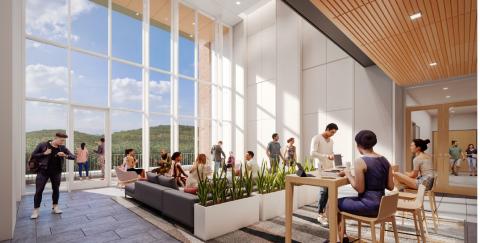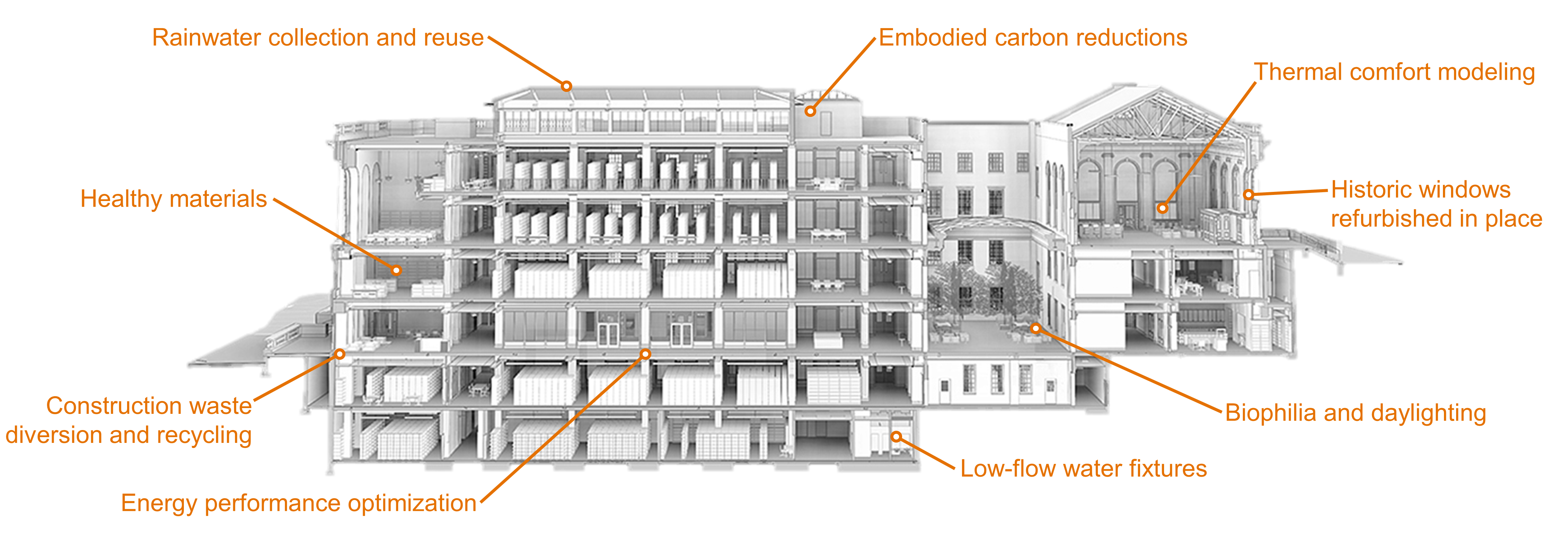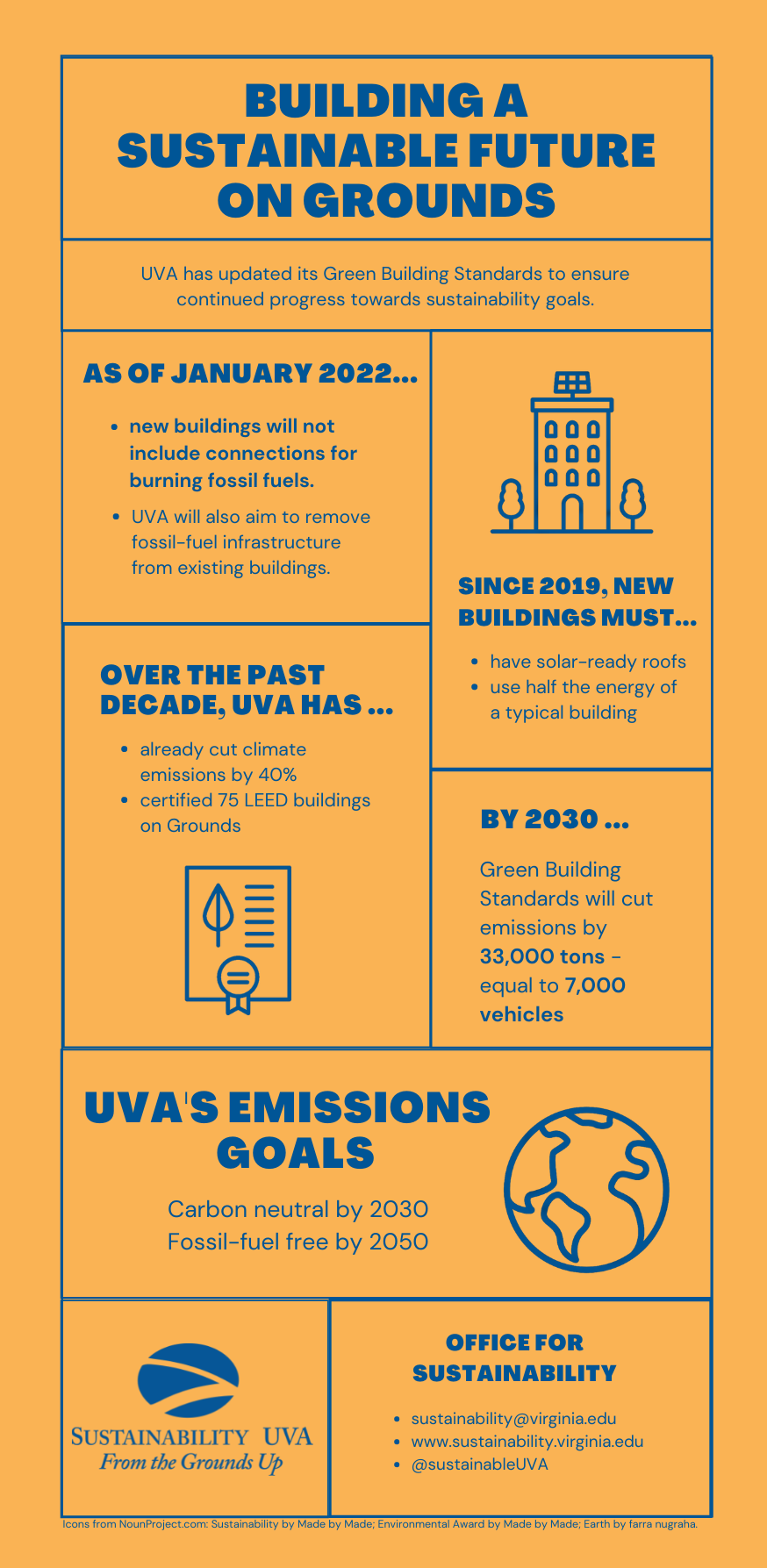Designing Buildings for Sustainability
The University of Virginia has updated its building standards required for all future construction projects to further the institution’s progress in meeting its goals to be carbon neutral by 2030 and fossil-fuel free by 2050. The updated standards come at a time when UVA is entering a growth phase, with several major projects in various stages of planning.
Starting this year, new buildings are restricted from adding infrastructure for the on-site combustion of fossil fuels, such as natural gas, for heating or other uses, unless required for safety or emergency back-up systems. The standards will apply to the Karsh Institute of Democracy and the Performing Arts Center, which are both early in the planning stages. In addition, the updated standards encourage the removal of fossil-fuel infrastructure in existing buildings.
The standards are an update to the University’s Green Building Standards, which have been in place since 2019. For example, buildings must be designed with solar-ready roofs and meet low-energy targets to ensure they use about half the energy of a typical new building. Over the next decade, the Green Building Standards are anticipated to reduce UVA’s yearly carbon emissions by 33,000 tons, equivalent to removing 7,000 vehicles from the roads each year.
“We have made tremendous strides in recent years to reduce the carbon footprint of the University’s physical presence and operations, and are excited to add these updated sustainable-design standards into the ongoing work to meet UVA’s goal to be carbon neutral by 2030,” said Andrea Trimble, Director of the Office for Sustainability.
UVA has 75 buildings that are LEED-certified, the globally recognized standard for sustainable building, with over a dozen more in the works (several have been recognized with state awards). The updated Green Building Standards go beyond the minimum design elements for LEED and augment UVA’s already robust guidelines to reduce waste and water consumption, improve health and enhance the University’s natural environment.
Other sustainability requirements that apply across Grounds include:
- Low-flow water fixtures;
- Recycling of plastic, metal, paper and construction waste (compost is encouraged);
- Use of low- or non-toxic materials, and high-efficiency filtration and ventilation to improve air quality;
- Low -trespass light fixtures for new buildings to protect the night sky and reduce negative impact on pollinators; and
- Drought-tolerant landscaping (irrigation is prohibited on landscapes and lawns), and minimal use of fertilizers and pesticides.
Based on these and other measures, the Main Library Renewal project, for example, is anticipated to cut carbon emissions, energy use – and costs – by about 50%. The library will also capture and recycle all rainwater on-site, about 600,000 gallons per year.
Sustainability is also integral to the recently completed Student Health and Wellness Center, the newest building in the University’s Brandon Avenue “Green Street” precinct. The center includes several health-focused measures, including low-emitting materials, natural daylighting, meditation rooms and high-efficiency air flow and filtration systems. The building was also designed to incorporate enough solar panels to offset the annual energy use of 15 homes.
“Working collaboratively with our project partners very early in design has been instrumental in meeting the University’s sustainability priorities on projects of all types and scales, and the Green Building Standards have provided clear direction in that regard,” said Amy Eichenberger, Senior Project Manager with Facilities Management. “And working closely with our UVA Sustainability staff members also provides direct support for analyzing challenges and opportunities specific to the University’s buildings and operations. I’m grateful to have these resources to further develop smart sustainable practices, especially during this dynamic period of growth at the University.”
UVA’s Green Building Standards update builds on a history of sustainable building practices on Grounds, which have contributed to a 40% reduction in carbon emissions and a 17% reduction in water consumption since 2010, all while adding more than 4 million square feet of building area during that same period.



